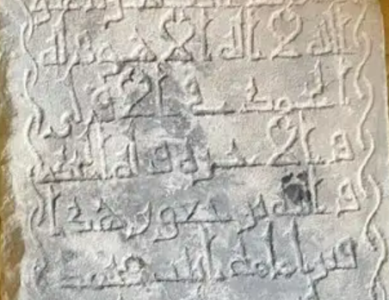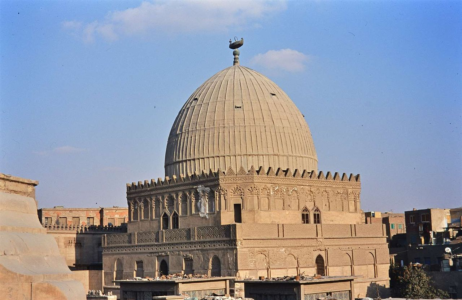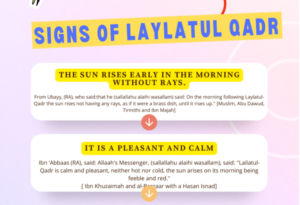1000 year old tombstone discovered in Imam Al-Shafi’i cemetery, CAIRO
Independent Egyptian heritage researchers have discovered an over 1000-year-old tombstone inscribed with ancient Kufic script in the ruins of an ancient cemetery in Cairo.
Amid the widespread demolition of several areas of the Imam Al-Shafi’i cemetery, a group of amateur and independent researchers uncovered the tombstone of a woman dating back 1,170 years.
This 1000 year old tombstone is the the tomb of a woman named Umamah bint Muhammad bin Yahya bin Khalid, who died in the month of Dhul Hijjah in the Hijri year 221 or 229.
Al-Sadiq said that the tombstone was handed over to the Ministry of Antiquities.
Read More Muslim News
Mustafa Al-Sadiq, a heritage researcher, announced discovering an over 1000-year-old tombstone inscribed with ancient Kufic script in the ruins of an ancient cemetery in Cairo

The 1000-year-old tombstone
Al-Sadiq, who published pictures of the tombstone, said that as the demolition was in progress, he went to the site to take a last look.
When he entered the cemetery yard, which was about to be razed, he was surprised to see a wall with some unpunctuated Kufic letters. A detailed look at the wall revealed a complete tombstone with writing in the unpunctuated Kufic script.
It appeared that the tombstone was used in the construction of the wall.

1000 year old Tombstones in historic Cairo are documents of information and dates for important areas and people, as they contain names, dates of death, and sometimes birth.
With help from specialist Faraj Al-Husseini, it became clear that the tombstone belonged to the tomb of a woman named Umamah bint Muhammad bin Yahya bin Khalid, who died in the month of Dhul Hijjah in the Hijri year 221 or 229.

Where is Imam al-Shafi’i mausoleum located?
- Located at the Imam Shafi’i Street in the City of the Dead, Cairo, the mausoleum is a hallmark of Ayyubid style architecture and historical significance. Imam al-Shafi’i travelled to Cairo in 813 where he taught at the Mosque of Amr ibn al-As, before his death in 819.
The Imam Al-Shafi’i cemetery, east of Cairo, in the valley of Mokattam Mountain, is part of the urban fabric of the historic city.
History of Imam Al-Shafi’i cemetery
Nearly four hundred years after the Imam’s death, the new Ayyubid sultan, Salah al-Din (Saladin), established a Sunni madrasa, an educational institution, in the cemetery near the tomb of Imam al-Shafi’i and commissioned a magnificent wooden cenotaph intricately carved of teak over the grave of Imam al-Shafi’i in 1178
Imam al-Shafi’i embarked on a journey to Cairo in 813, where he assumed the role of an educator at the Mosque of Amr ibn al-As. He continued in this capacity until his passing in 819. His final resting place was selected by his child Ibn Abdulhakim, who laid him to rest in the City of the Dead on a site marked by a turbah.
Subsequently, in 1176, during the reign of the Ayyubid sultan Salah ad-Din, a turbah and a madrasa were constructed in honor of Shafi’i, thus establishing the first commemorative structure at his gravesite. A wooden coffin, adorned with intricate Islamic geometric motifs and inscriptions of verses from the Quran, along with depictions of Shafi’i’s life in Kufic and Ayyub scripts, was crafted in 1178. The artist responsible for these embellishments was Abid al-Najar.
In the year 1211, following the demise of the mother of Ayyub Sultan Al-Kamil, the sultan commissioned the construction of a mausoleum adjacent to the existing site. This new addition encompassed a dome and an edifice that covered the entirety of the area, including al-Shafi’i’s resting place.
This architectural configuration persists to the present day, characterized by a wooden dome that was later augmented with muqarnas and marble ornamentation, as provided by the Mamluk Sultan Qaitbay in 1480. Over time, the structure underwent restoration efforts during the reign of the Mamluk Sultan al-Ghuri and the Ottoman wali Ali Bey al-Kabir in 1772. Notably, they introduced vibrant embellishments to the inner walls, as well as additional muqarnas and enhancements to the dome.
News Ref : 1000 year old tombstone discovered in Imam Al-Shafi’i cemetery, CAIRO Arab news
Discover more from Islam Hashtag
Subscribe to get the latest posts sent to your email.





